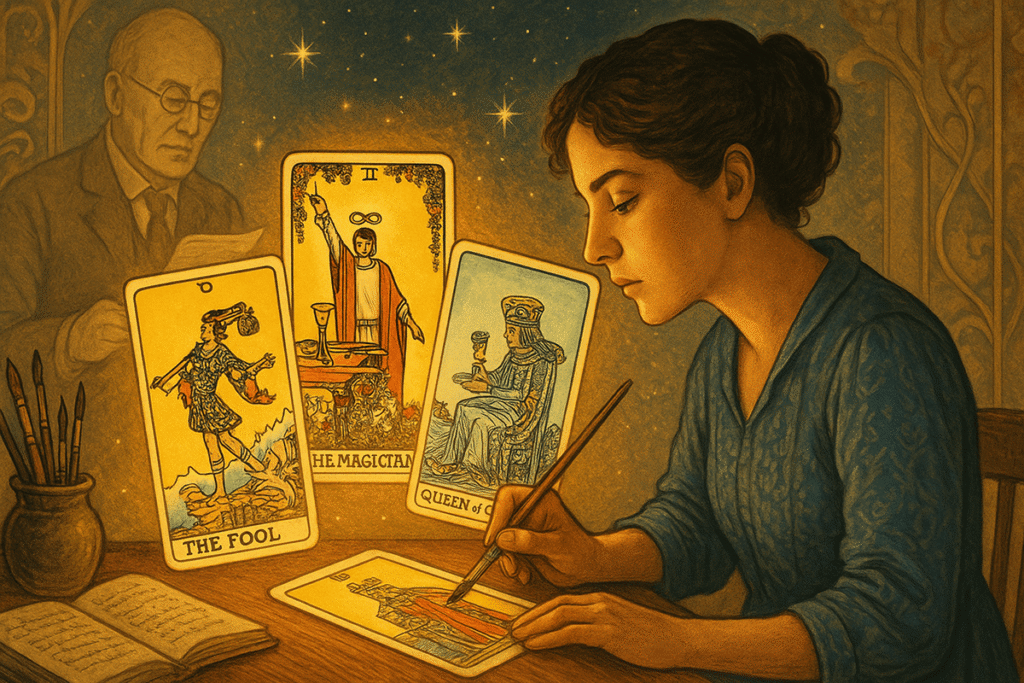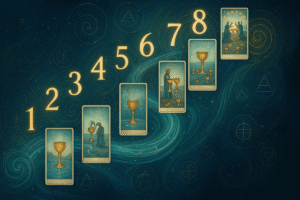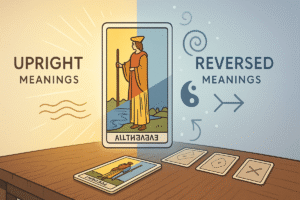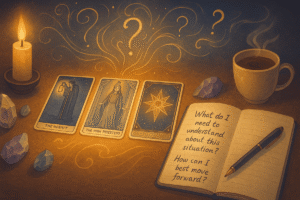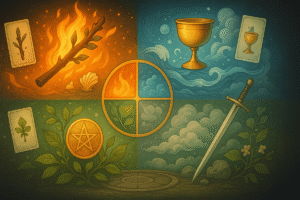Table of Contents
When I first encountered a tarot deck years ago, it was almost certainly a Rider-Waite-Smith. Perhaps you’ve had a similar experience. There’s something both familiar and mysterious about those distinctive illustrations that seem to appear everywhere from bookshops to movies. But what makes this particular deck so special, and why has it dominated the tarot world for over a century?
The story behind the Rider-Waite-Smith tarot is more fascinating than many realize, involving an unlikely collaboration between a scholarly mystic, a talented artist whose contributions were overlooked for decades, and a publisher willing to take a chance on what would become the most influential tarot deck in modern history.
The Origins of a Revolutionary Deck
The Rider-Waite-Smith tarot emerged in 1909 from the collaboration between Arthur Edward Waite, a British mystic and scholar, and Pamela Colman Smith, an artist and illustrator. The deck was published by Rider & Company, hence the name that stuck for so many years.
Waite had specific ideas about how tarot should be presented to the public. He wasn’t interested in creating just another fortune-telling deck. Instead, he envisioned something that could serve as a tool for spiritual development and self-reflection. This intention shaped every aspect of the deck’s design and symbolism.
What’s particularly interesting is how Waite approached the project with scholarly precision. He drew from his extensive knowledge of occult traditions, Christian mysticism, and symbolism. Yet he also wanted to make tarot more accessible to ordinary people, not just initiates of secret societies.
The timing couldn’t have been better. The early 1900s saw a surge of interest in spiritualism and alternative forms of wisdom. People were hungry for tools that might help them explore life’s deeper questions, and tarot was perfectly positioned to meet this need.
Pamela Colman Smith’s Artistic Vision
For many decades, Pamela Colman Smith’s contribution was largely forgotten, overshadowed by Waite’s name prominence. This seems particularly unfair when you consider that her artistic choices are what made the deck truly revolutionary.
Smith wasn’t just following Waite’s instructions blindly. She brought her own artistic sensibilities and understanding of symbolism to the project. Her background in theater and illustration informed her approach to creating images that would tell stories at a glance.
The colors she chose, the poses of the figures, the way she arranged symbolic elements within each card all these decisions came from her creative vision. She had to translate Waite’s sometimes abstract concepts into concrete, meaningful images that would speak to people’s intuition.
I find it remarkable how Smith managed to create 78 distinct images that feel cohesive while still allowing each card to maintain its own character. Her artistic consistency gives the deck a unified voice, yet each card invites contemplation in its own unique way.
The Revolutionary Minor Arcana
Perhaps the most groundbreaking aspect of the Rider-Waite-Smith deck was its fully illustrated Minor Arcana. Before this deck, most tarot cards showed only the suit symbols for the numbered cards. Imagine trying to interpret a card showing nothing but five swords or three cups.
Smith changed everything by creating narrative scenes for each Minor Arcana card. Suddenly, the Three of Swords didn’t just represent the concept of heartbreak; it showed a heart pierced by three swords against a stormy sky. The Five of Pentacles depicted two figures in the snow, suggesting themes of hardship and seeking shelter.
This innovation transformed tarot from something requiring extensive memorization into a more intuitive practice. People could look at the cards and begin to understand their meanings through the visual stories being told. It democratized tarot in a way that hadn’t been possible before.
The psychological depth Smith brought to these illustrations is impressive. She understood that people needed visual anchors for abstract concepts. Her scenes don’t just illustrate meanings; they evoke feelings and memories that help readers connect personally with each card’s message.
Why It Became the Standard
The success of the Rider-Waite-Smith deck wasn’t immediate, but it was inevitable. Several factors contributed to its eventual dominance in the tarot world.
First, the accessibility factor cannot be overstated. New tarot readers could pick up this deck and begin exploring without years of study. The images spoke directly to the unconscious mind, making interpretation feel natural rather than forced.
The deck’s symbolic language also struck a perfect balance between depth and clarity. Experienced readers could find layers of meaning to explore, while beginners weren’t overwhelmed by overly complex imagery. This broad appeal helped it gain traction across different audiences.
Publishing and distribution played crucial roles too. Rider & Company’s decision to keep the deck in print meant it remained available when other decks disappeared from shelves. As tarot’s popularity grew throughout the 20th century, the Rider-Waite-Smith was often the only option available in many bookstores.
Perhaps most importantly, this deck became the foundation for countless tarot books and educational materials. Authors naturally gravitated toward using it as their primary reference, which created a feedback loop that reinforced its position as the standard.
The Deck’s Lasting Influence
Walking into any bookstore today, you’ll likely encounter dozens of tarot decks that clearly draw inspiration from the Rider-Waite-Smith tradition. The basic structure, the symbolic language, even the artistic approach of many modern decks can trace their lineage back to this 1909 creation.
This influence extends beyond just visual similarities. The way we think about tarot readings, the meanings we associate with specific cards, and the methods we use for interpretation have all been shaped by the Rider-Waite-Smith system. It created a common vocabulary for the tarot community.
Modern deck creators often deliberately reference or reinterpret Smith’s imagery, knowing that readers will recognize and connect with these familiar visual themes. It’s become a kind of universal language within the tarot world.
Yet the deck’s influence goes deeper than just aesthetics. The reflective, introspective approach that Waite envisioned has become the dominant way people engage with tarot today. Rather than seeking definitive predictions, most modern readers use tarot as a tool for self-exploration and personal insight.
Understanding Its Enduring Appeal
What continues to draw people to the Rider-Waite-Smith deck after more than a century? I think it’s the perfect storm of accessibility, depth, and artistic coherence that Smith and Waite achieved.
The deck invites contemplation without being intimidating. Each card offers multiple entry points for reflection, whether you’re drawn to the main figures, the background details, or the overall emotional tone of the scene. This flexibility makes it suitable for different reading styles and personal approaches to tarot.
There’s also something timeless about Smith’s artistic choices. While the clothing and settings clearly belong to her era, the human emotions and experiences depicted in the cards remain universally relevant. Love, loss, hope, fear, achievement, and struggle these themes resonate just as strongly today as they did in 1909.
The deck’s reputation for being beginner-friendly doesn’t diminish its value for experienced readers. Instead, it offers different levels of engagement depending on how deeply you choose to explore its symbolism. This layered approach ensures that the deck can grow with a reader over time.
A Foundation for Personal Exploration
Today’s tarot enthusiasts often begin their journey with the Rider-Waite-Smith deck, and for good reason. It provides a solid foundation for understanding tarot’s symbolic language and developing personal reading practices.
The deck encourages a reflective approach that focuses on questions rather than answers. Instead of telling you what will happen, it invites you to explore what might be happening within yourself. This shift in perspective aligns perfectly with how many people prefer to engage with tarot in our modern context.
Whether you’re drawn to the historical significance, the artistic achievement, or simply the practical accessibility of the Rider-Waite-Smith tarot, you’re connecting with over a century of readers who have found meaning in these 78 cards. Perhaps that’s the most remarkable aspect of all: how a collaboration between two individuals in 1909 continues to facilitate personal reflection and insight for millions of people worldwide.
The Rider-Waite-Smith tarot remains a testament to the power of combining scholarly knowledge with artistic vision, creating something that transcends its original time and place to offer lasting value for anyone seeking deeper self-understanding.
Frequently Asked Questions
Why is it called Rider-Waite-Smith instead of just Rider-Waite?
The modern tarot community has been adding Smith’s name to properly credit Pamela Colman Smith’s artistic contribution, which was historically overlooked when only the publisher’s name (Rider) and Waite’s name were used. For decades, Smith received a flat fee for her work and wasn’t credited on most editions, despite her artwork being central to the deck’s success and influence.
Are there different versions of the Rider-Waite-Smith deck, and does it matter which one I buy?
Multiple versions exist with variations in coloring, line work, and card borders. Popular modern versions include the Centennial Edition (which attempts to reproduce the original 1909 colors), the Universal Waite (with softer, recolored artwork by Mary Hanson Roberts), and the Radiant Rider Waite (with more vibrant colors). The choice often comes down to personal aesthetic preference, as all versions maintain the same basic symbolism and structure.
Can I learn other tarot decks after learning the Rider-Waite-Smith?
Since many modern decks are based on the RWS system and use its pictorial language translated into different artistic styles, knowing the foundational imagery makes it easier to read RWS-inspired decks. The deck has become the common reference point for most tarot learning materials, books, and courses, which means your knowledge compounds as you continue exploring tarot.

